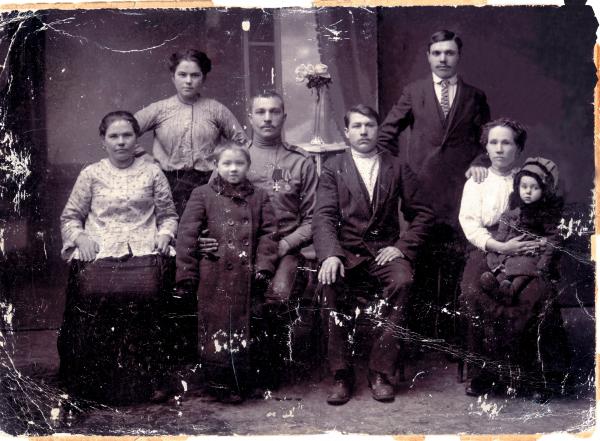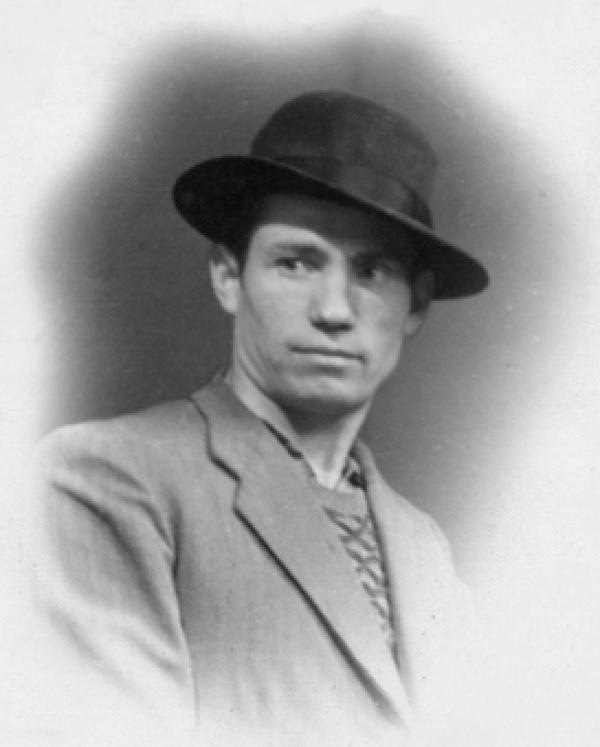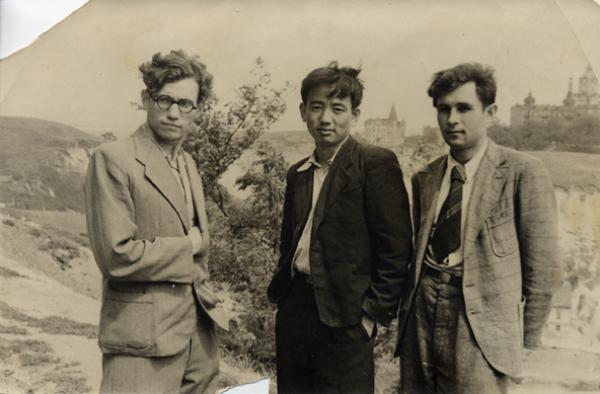He was born on July 7 in Rzhyshchiv, Kyiv region. The boy became an orphan early on: his mother died when he was just one year old, and eleven years later, he lost his father. After his father's death, Ivan lived on the streets of Kyiv until he was taken into care by the Friends of Children Society.
1934Forced to support himself, he starts working as a fireman, courier, etc., in the newspaper "Visti". Despite the difficult living conditions, he continues to paint a lot. At this time, his foster family gives him a middle name — Valentyn.
1937–1939Studies at Taras Shevchenko Kyiv Art Secondary School.
1939Attempts to join the Joint School of the Caspian Military Flotilla in Baku, but fails due to health reasons. However, he remains working as a librarian at the school.
1941–1945From the beginning of the war, he was on the frontline as a part of the 68th Marine Rifle Brigade. After receiving two wounds (1942, 1943), he served in the 29th Reserve Rifle Division in Vologda, from 1945 — in the White Sea Military District’s headquarters near Arkhangelsk, mostly performing art and design work. In 1943, Zadorozhnyi was sent to a camp based on unsupported charges but was acquitted six months later.
1945–1951He studies at the Kyiv State Art Institute in the studio of Kostiantyn Eleva and Anatol Petrytsky. Within this period, he works on political posters, the painting "For Peace", which was exhibited at the All-Union Art Exhibition, and other works on historical and revolutionary topics. Painted in the tradition of socialist realism of the Stalin era, these works show an ideological and, most importantly, professional oppression of students.
1954Finishes postgraduate studies, which result in a monumental painting "Bogdan Khmelnytsky leaves his son Tymish as a pledge to the Crimean khan." The artist has yet to overcome the style acquired at the art institute, but the national-historical motifs have become prevalent in his work since then.
The second half of the 1950s – the first half of the 1960sHe creates many paintings on the events of World War II: "They are immortal. Krasnodontsi” (1955), “Sonata” (1956–1957), “Appassionata” (1960),“ In the Name of Life ”(1963). In the works of the early 1960s, in particular in the painting "Mother. 37th year” (1962–1963), the search for the individual new plastic language can be traced. A milestone of this search is the painting "My Countrymen" ("On the site of past battles", 1965) — one of the best examples of the Ukrainian variety of the so-called strict style, which became especially popular among young artists. The programmability of the work is emphasized by the introduction of a self-portrait into the composition. This work causes controversy in the artistic community, and the author is accused of formalism, nationalism, Boychukism, etc.
1965–1967Works on the painting "Wedding", which is usually associated with the highest mastery of this work period. The monumental look is combined with the theme’s chamber solution, sending the viewer to the style introduced into Ukrainian art by Tetyana Yablonska.
1969Together with Vasyl Perevalsky and Fedor Glushchuk, works on creating a stained glass window for the lobby in Taras Shevchenko Kyiv State University, which would be to be installed on the site of the destroyed work of Alla Horska and her colleagues.
1970Paints "Gardens to Bloom" — a philosophical comprehension of the war, which was witnessed by the artist. Just as Anatol Petrytsky in "Invalids", Zadorozhnyi shows not the heroic but rather its tragic side through the images of a blind soldier and his mother-guide. This painting contradicts the atmosphere of loud celebrations of Victory Day, which were one of the symbols of the Brezhnev era.
1971–1972Creates monumental and decorative compositions in Kremenchuk, particularly the stained glass window "Our song is our glory" and the cement relief "Wedding feast" for the City Palace of Culture, and mosaic panel "My Motherland" for the Dormash plant (now Kredmash) Palace of Culture.
1972–1974Performs monumental and decorative design of the House of Culture and the wedding hall in Kalyta village, Kyiv region (stained glass "Necklace", wall painting "Guelder rose flute"; mosaic "Oh you, evening star", cement relief "Petals", decorative stelas). Nadiya Zadorozhna, the artist's widow, says: "His fascination with folk songs was visible in full force: each motif is outlined by a contour line, which include related inscriptions and quotations”1. These formal findings will later be transferred to painting, marking the birth of the artist's unique individual style.
1973Starts a series of portraits of prominent figures of Ukrainian history — Yaroslav the Wise, Petro Mohyla (1973), Hryhoriy Skovoroda ("Poet and Queen", 1973–1975), Levko Symyrenko (1975, 1977–1979), Marusia Churai (1975–1977), Yuriy Kondratyuk (1976–1979), Nastya Lisovska (Roksolana, 1977).
1974Paints "Family Portrait", where he portrays himself, his wife Nadiya, daughter Natalia and son Bohdan. Iryna Mishchenko, the author of the introduction article to Zadorozhnyi's album (2017), notes the influences of icon painting and folk art in this and other canvases of the artist within the 1970s and 1980s.
Destroys some of his own works, primarily socialist-realistic. This symbolic gesture testifies to the worldview and creative choice of the artist made a decade earlier.
1976Begins work on the most monumental order of his career — the interior design of the Lybid hotel in Kyiv. Within six years, the artist not only creates monumental compositions, but also develops sketches of furniture, lamps, utensils, and more. Particularly impressive are the so-called pagan idols - decorative images of Slavic gods carved in mahogany.
1976–1978Carves a monumental panel "Scythia" for the interior of the Prolisok motel-camping in Kyiv.
1976–1979Works on the monumental stained glass "People, take care of the Earth!" in the Rosava Palace of Culture in Bila Tserkva. As in other stained-glass windows by Zadorozhnyi, the color of cast glass has a very special intensity and almost painterly expressiveness.
1976–1979Creates a monumental-spatial composition for the interior of the Chernihiv Literary-Memorial Museum of M. Kotsiubynsky. A ten-meter column running through the three floors of the building is covered with wood-carved images of the heroes of the writer's work.
1980sHe continues to work on portraits of historical figures, creating images of Nestor the Chronicler (1980–1984), Alipy (1981–1985), Kindrat Ryleyev (1982), and Maxym Berezovsky (1985). The highest point of this unique gallery is canvas the "Hymn to Folk Art" (1988), dedicated to folk artists Maria Pryimachenko and Oleksandr Hanzha.
Working on orders for the design of public buildings, he created several tapestries, including "Kyi" for the lobby of the Kyiv hotel "Lybid" (1982-1986, partially preserved) and "Family" for the Palace of Culture in the village of Rogizka in Vinnytsia region (1987- 1988).
Till the end of his life, he works on a series of illustrations for Taras Shevchenko's Kobzar.
1980–1982Paints one of the most common Ukrainian folklore images — Cossack Mamay, who in Zadorozhnyi's painting mocks the devil-lord, the young prostitute and the fancy death.
1980–1983Works on illustrations for the Ukrainian folk tale “Kyrylo Kozhumyaka” for the publishing house “Veselka”.
1983–1985Paints "Daily Bread", in which Mykhailo Boichuk and his school’s influence are especially noticeable.
1984Creates decorative stained glass for the upper station of the Kyiv funicular.
1987–1988Works on the painting "Dance of Sorrow": "Perceived as the embodiment of the missing, lost, the canvas seems to swell with a note of regret for what has passed"2.
1988He dies in Kyiv on October 21. He was buried next to his mother on the Dnipro slopes in Rzhyshchev. The tombstone, designed by Zadorozhnyi himself, was created by Mykola Malyshko.
2 Ivan-Valentyn Zadorozhnyi: album / author's introductory article by I. Mishchenko. Kyiv: Sofia-A. 2017. P. 9.



